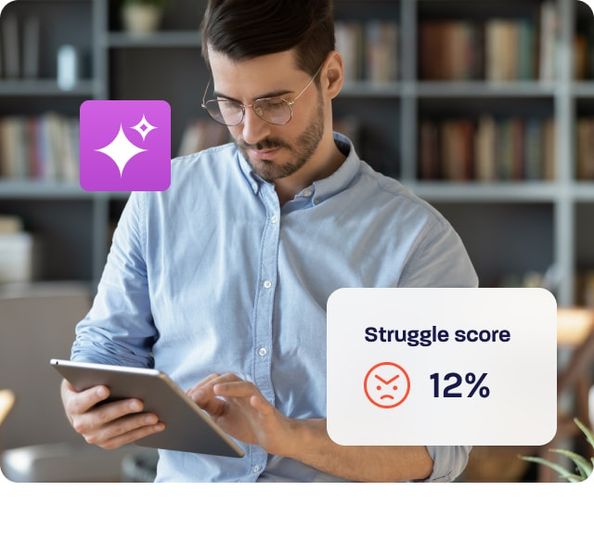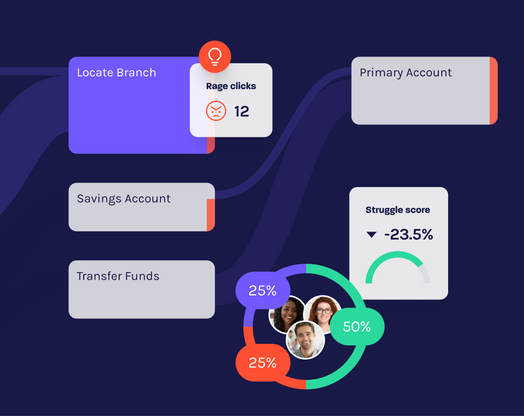
Creating Digital Experience With Website Personalization
Website personalization turns static content into tailored experiences that feel intuitive, shaping how each website visitor engages, converts and returns.
By using web personalization tools to adapt content, layouts and recommendations based on user behavior and customer data, businesses can deliver more relevant, human experiences. Whether it’s ecommerce personalization that adjusts product listings in real time or contextual personalization that surfaces the right content based on browsing history, personalization drives loyalty, conversions and trust.
This strategy goes beyond simple tweaks. It brings together visitor data, omnichannel marketing insights and analytic tools to create seamless, personalized experiences across every digital touchpoint.
In this blog, we’ll cover what website personalization means today, why it matters for customer experience and how to implement it effectively.
What Is Website Personalization?
Website personalization is the practice of tailoring site content, layouts, messaging and offers to individual users based on real-time data. Instead of serving everyone the same static experience, personalization uses dynamic content to align with each website visitor’s goals, creating a more relevant, personalized experience every time they return.
Today’s strategies go beyond basic personalization efforts like name fields in email marketing. Leading brands use contextual personalization to recognize user intent and serve personalized content that supports it—whether that’s showing relevant insurance policies, surfacing financial calculators or adapting homepage modules in real time.
Ecommerce personalization is a prime example: A returning shopper might see curated product recommendations or stock updates based on previous browsing history. On the telecom side, visitors comparing plans might receive tailored upgrade options. Analytic tools identify top-performing journeys, while website personalization tools deliver those insights as custom experiences on the site.
Platforms like Glassbox enhance these efforts through tagless data capture, enabling businesses to track 100% of user interactions without relying on manually placed tags. That means more complete visitor data and better inputs for building high-performing, behavior-based personalization strategies.
Why Personalization Is the Key to Better Digital Experiences
Modern digital experiences depend on how well businesses respond to individual user needs in real time. Personalization makes that possible by using visitor data—such as browsing patterns, device type and repeat behaviors—to deliver relevant content, personalized recommendations and dynamic layouts that reflect the user’s context.
And it works. According to PwC, 73% of consumers say customer experience heavily influences their buying decisions. McKinsey reports that companies leading in personalization see a 10–15% revenue lift and 20% higher customer satisfaction scores.
Effective website personalization supports:
Higher engagement: Personalized experiences keep visitors exploring longer by showing relevant, timely content.
Lower bounce rates: Dynamic content tailored to browsing behavior helps visitors find what they’re looking for faster.
More conversions: Whether it’s ecommerce personalization at checkout or personalized product recommendations, users are more likely to act when experiences reflect their intent.
Greater loyalty: Returning users appreciate consistency and recognition—key factors in long-term customer retention.
Better self-service: Personalization can enhance user experience through customized FAQs, dashboards or digital support journeys.
In short, personalization doesn’t just make digital content more relevant. It transforms the entire customer experience into something more intuitive, satisfying and conversion-friendly.
4 Core Building Blocks of Personalization That Performs
Successful personalization strategies often rely on the “four D’s” framework: Data, Design, Delivery and Decisioning.
Glassbox empowers this framework with web personalization tools that combine customer journey analytics, behavioral segmentation and real-time data.
Here’s how:
1. Data
Personalization starts with gathering comprehensive user data, including browsing behavior, demographics and contextual signals like device type or location. For instance:
A finance platform tracking user behavior might serve calculators tailored to loan preferences.
E-commerce personalization dynamically updates product listings based on browsing behavior or purchase patterns.
Visitor behavior insights can help identify friction points in the customer journey, enabling businesses to deliver more effective content personalization.
Glassbox’s tagless data capture ensures businesses collect accurate, complete data across all user interactions, eliminating gaps and improving personalization effectiveness.
2. Design
Creating modular page layouts allows businesses to dynamically display personalized content. For example:
A returning finance customer could see a dashboard with updated mortgage rates and calculators.
A retail shopper might find curated suggestions for new arrivals or complementary items.
Dynamic content ensures visitors receive the most relevant information without navigating through unrelated pages. Glassbox’s tools support this by analyzing visitor data and enabling quick adjustments to layouts based on user behavior.
3. Delivery
AI-driven delivery enables businesses to provide real-time personalized recommendations, such as:
“Visitors who viewed X also bought Y.”
“Based on your recent searches, here’s a tailored offer for your unique experience.”
These tailored recommendations can help ecommerce platforms upsell products during checkout.
Glassbox’s AI capabilities analyze user behavior at scale, enabling businesses to deliver context-aware recommendations and dynamic content that boost conversions.
4. Decisioning
Automated decisioning transforms insights into immediate actions, such as:
Sending cart recovery emails to ecommerce visitors who abandoned their shopping carts
Displaying fraud alerts for suspicious behavior on a financial platform
Using personalization tools to identify and target visitors with personalized ads based on browsing behavior
By automating personalization efforts, businesses can respond to user needs instantly, enhancing trust and engagement.
How To Implement a Website Personalization Strategy
Website personalization requires a thoughtful strategy backed by clean data, clear goals and the right tools.
Here’s a step-by-step approach to help you build and scale a personalization strategy that drives engagement, conversions and long-term customer experience improvements:
1. Set Clear Goals
Start by defining what you want to achieve: Higher conversions? Improved retention? Increased engagement with personalized content? Setting measurable goals will guide your personalization efforts and help you track success.
2. Audit Existing Journeys
Analyze user journeys to map how website visitors navigate your site. Where do they bounce? Where do they convert? Identify friction points, repeated behaviors and missed opportunities to introduce dynamic content.
3. Segment Based on Behavior
Go beyond demographic data. Segment your audience using browsing behavior, scroll depth and interaction history to serve relevant content and product recommendations. Ecommerce personalization, for example, often starts with users who revisit the same category pages or abandon carts.
4. Define Personalization Use Cases
Start small with quick wins, like customizing homepage modules for returning users or personalizing CTAs on product detail pages. Email marketing campaigns can also benefit from behavior-based segmentation tied to browsing history.
5. Choose the Right Website Personalization Tools
Look for tools that provide full visibility into visitor data, not just tagged events. Platforms like Glassbox offer tagless data capture, session replay and real-time insights across channels to fuel smarter personalization strategies.
6. Test, Measure, Iterate
Website personalization isn’t a one-time task. Run A/B tests, monitor KPIs like bounce rate and time on page, and refine based on what your visitor behavior tells you.
7. Ensure Compliance From the Start
With personalization comes responsibility. Make sure your strategy aligns with regulations like GDPR and CCPA, especially when handling customer data. Glassbox helps ensure compliance through automatic data anonymization and privacy-first design.
KPIs To Measure Website Personalization Success
To gauge the impact of your website personalization strategy, tracking the right performance indicators is essential. These KPIs help evaluate whether your personalized experiences are resonating with visitors and contributing to business outcomes:
Engagement: Look at time on site, scroll depth and pages per session. Higher engagement signals that personalized content is keeping users interested and exploring.
Bounce Rate: A lower bounce rate typically reflects more relevant, personalized experiences that help visitors find what they need faster.
Conversion Rate: Whether it's ecommerce personalization that recommends add-ons or contextual personalization that surfaces the right CTA, personalized experiences lead to higher conversion rates.
Customer Retention: Repeat visits, longer time between bounces and lifetime value all improve when users feel recognized and supported across each digital touchpoint.
Platforms like Glassbox make it easy to monitor these metrics in real time by connecting visitor data with session replay, behavioral analysis and performance trends—all without the limitations of manual tagging.
Website Personalization Examples by Industry
Personalization looks different for different types of customers. Here’s how businesses across industries are creating customized experiences that drive engagement, reduce friction and increase conversions:
Finance: Help visitors move efficiently through complex decisions, like applying for loans or comparing rates, by using behavioral signals to offer calculators, rate tools or chatbot support at the right time.
Insurance: Surface relevant policy recommendations based on browsing behavior, device type or session depth. A mobile user researching renters insurance, for example, might see location-based offers or FAQs matched to their intent.
Retail: Dynamically reorder product listings, show personalized stock alerts or offer discounts based on a shopper’s browsing history. Personalized recommendations during checkout can also boost average order value.
Telecom: Use visitor behavior data to identify interest in upgrades, then personalize homepage banners or plan comparisons accordingly. Returning users might see reminders to complete a plan switch or explore new add-ons.
Government & Public Sector: Segment users by role (e.g., citizen vs. business) or location to display relevant content faster. A local business might be guided directly to tax forms or permit applications, while citizens see local service updates.
By combining real-time data, dynamic content and contextual personalization, organizations across sectors are reshaping the digital experience to meet user expectations and boost results.
Solving Website Personalization Challenges With Better Data
Even the most sophisticated website personalization strategy can stall without the right data infrastructure. Common roadblocks include:
Disjointed User Journeys: Visitors move between devices, channels and sessions. Yet most personalization tools struggle to maintain a cohesive view across touchpoints.
Siloed Teams and Data: Marketing, product and IT often operate in isolation, using separate tools and inconsistent metrics. This fragmentation hinders effective personalization efforts.
Limited Behavioral Insight: Traditional page-level analytics don’t explain why users drop off, miss CTAs or abandon sessions. Without visibility into user behavior, teams are guessing.
Over-Reliance on Rules: Static personalization rules break down when customer behavior shifts quickly, leaving websites out of sync with user intent.
Privacy and Compliance Pressure: Regulatory frameworks like GDPR and CCPA add complexity. Personalization efforts must be compliant by design, not an afterthought.
Glassbox helps teams overcome these challenges by connecting the dots between data and experience:
Tagless Data Capture ensures 100% of user interactions are recorded without manual tagging or guesswork, providing a full, real-time view of the customer journey.
Session Replay reveals the why behind user actions, giving teams the insight they need to improve personalization strategies across web and mobile experiences.
Automatic Data Anonymization simplifies privacy compliance while still enabling teams to act on behavioral insights with confidence.
With better behavioral data at your fingertips, your team can replace assumptions with action and build personalization strategies that evolve alongside your users.
Bring Personalization to Life With Glassbox
Website personalization isn’t just a marketing tactic—it’s the foundation of a smarter, more satisfying digital experience. But to work, it has to be powered by real data, seamless tools and a clear view of every visitor interaction.
Glassbox delivers exactly that. From tagless data capture and AI-driven recommendations to session-level insights and real-time visualizations, our platform gives teams everything they need to build and scale personalized experiences that drive loyalty and conversions.
Whether you’re optimizing ecommerce personalization, refining contextual content or future-proofing your customer experience strategy, Glassbox helps you personalize with precision.
Ready to elevate your personalization efforts? Take the platform tour and see what’s possible when every click, scroll and interaction is captured and turned into action.







